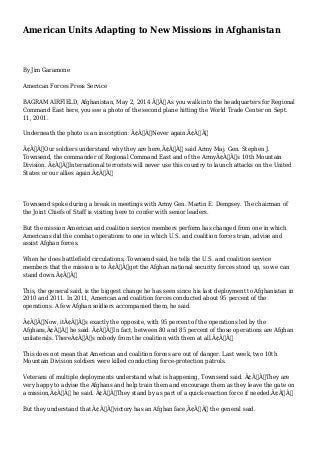
American Units Adapting to New Missions in Afghanistan
- 1. American Units Adapting to New Missions in Afghanistan By Jim Garamone American Forces Press Service BAGRAM AIRFIELD, Afghanistan, May 2, 2014 – As you walk into the headquarters for Regional Command East here, you see a photo of the second plane hitting the World Trade Center on Sept. 11, 2001. Underneath the photo is an inscription: “Never again.†“Our soldiers understand why they are here,†said Army Maj. Gen. Stephen J. Townsend, the commander of Regional Command East and of the Army’s 10th Mountain Division. “International terrorists will never use this country to launch attacks on the United States or our allies again.†Townsend spoke during a break in meetings with Army Gen. Martin E. Dempsey. The chairman of the Joint Chiefs of Staff is visiting here to confer with senior leaders. But the mission American and coalition service members perform has changed from one in which Americans did the combat operations to one in which U.S. and coalition forces train, advise and assist Afghan forces. When he does battlefield circulations, Townsend said, he tells the U.S. and coalition service members that the mission is to “get the Afghan national security forces stood up, so we can stand down.†This, the general said, is the biggest change he has seen since his last deployment to Afghanistan in 2010 and 2011. In 2011, American and coalition forces conducted about 95 percent of the operations. A few Afghan soldiers accompanied them, he said. “Now, it’s exactly the opposite, with 95 percent of the operations led by the Afghans,†he said. “In fact, between 80 and 85 percent of those operations are Afghan unilaterals. There’s nobody from the coalition with them at all.†This does not mean that American and coalition forces are out of danger. Last week, two 10th Mountain Division soldiers were killed conducting force-protection patrols. Veterans of multiple deployments understand what is happening, Townsend said. “They are very happy to advise the Afghans and help train them and encourage them as they leave the gate on a mission,†he said. “They stand by as part of a quick-reaction force if needed.†But they understand that “victory has an Afghan face,†the general said.
- 2. The mantra now is to train the trainer. U.S. forces train Afghan officers and sergeants, who in turn train Afghan privates. “That’s the only way we can build an institution that can sustain itself,†Townsend said. The effort also is transitioning from unit-based security force assistance to functionally based assistance. In the past, American soldiers have been covering down on Afghan kandaks, or brigades, to train all aspects of what that unit needed to function effectively. “Now we are shifting our lens to functions -- critical functions,†he said. Logistics and intelligence are two of these critical functions. Training now strives to connect kandaks through the chain of command to the Afghan Defense Ministry. “A lot of the Afghan units are functioning just fine,†Townsend said. But they do need things from outside the unit to perform best, he added. Spare parts, replacements and intelligence sharing are examples of functions outside a unit that are critical to the unit’s success, he explained. “We’re trying to get the Afghans to push their intelligence down through channels to the unit that needs it,†he said. “We’re trying to make that pipe work.†With logistics, the Afghans have no historical data to forecast what spares will be needed. As a result, they are still buying bulk parts. This is inefficient, the general said, because “you end up buying too many of one widget and too few of another.†“They don’t have enough money to be inefficient and wasteful,†he added. “They have to be very efficient. We’re trying to help them maximize their bang for the buck.†When Townsend speaks with U.S. and coalition troops, he said, they ask him about the status of the bilateral security agreement that would allow a continued U.S. presence in Afghanistan beyond this year. They also ask if the United States will leave a residual force in Afghanistan, and what it will do. “They may operate at the foxhole-and-rifle squad level, but they think at a national level,†he said. The general said he believes Americans should know about the work his troopers are doing here. “We lost a soldier, … and I read a post on the Internet from an American that said, ‘I thought we were out of there,’†Townsend said. “The American people need to know we are still here and doing the nation’s mission.†(Follow Jim Garamone on Twitter: @GaramoneAFPS)